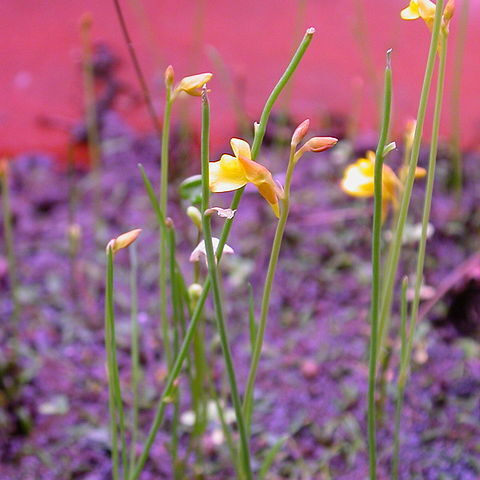Terrestrial. Rhizoids few, capillary, basally thickened, with numerous papillose branches 0.5-1 mm long. Stolons few, capillary, branched. Foliar organs usually ± conspicuous at anthesis on the stolons, narrowly linear, membranous, 1-2 cm long, up to 1 mm wide, 1-nerved, apex rounded. Traps on the vegetative organs, globose, 0.6-1 mm long, stalked, mouth basal, upper lip with 2 simple subulate appendages, lower lip with a ± well developed obtuse swelling at the distal end of the stalk. Inflorescence erect, 5-20 cm long; peduncle filiform, terete, glabrous above, minutely glandular below; flowers 1-10, distant; scales few, similar to the bracts; bracts basifixed, broadly ovate-oblong, obtuse, c. 1 mm long; bracteoles linear-subulate, c. 0.5 mm long; pedicels erect at anthesis strongly recurved in fruit, filiform, distinctly winged, 2-4 mm long. Calyx lobes subequal, the upper slightly larger, broadly ovate, base ± broadly connate and decurrent, apex obtuse, c. 3 mm long at anthesis, up to 6 mm long in fruit. Corolla yellow, 6-10 mm long, upper lip narrowly oblong, 1-2 mm wide, apex rounded, slightly longer than upper calyx lobe, lower lip ± orbicular, up to 4 mm wide, apex rounded, palate conspicuously raised, gibbous, spur subulate, acute, curved, longer than and widely diverging from the lower lip. Filaments oblong, straight, c. 1 mm long, c. 0.5 mm wide, anther thecae subdistinct. Ovary ovoid, style short but distinct, stigma lower lip quadrate, de-flexed, upper lip much shorter, entire or bidenticu-late. Capsule broadly elliptic, dorsiventrally compressed, uniformly membranous, 2.5-3 mm long, dehiscing by a single ventral longitudinal slit. Seeds numerous, ± ovoid, c. 0.4 mm long, testa rugose, reticulate, reticulations relatively large, elongate.
More
Annuals, terrestrial. Rhizoids and stolons capillary, branched. Traps on stolons and leaves, shortly stalked, globose, 0.5-1 mm, mouth basal; appendages 2, dorsal, subulate, curved. Leaves arising from stolon nodes, few to numerous, petiolate; leaf blade narrowly linear to linear-oblanceolate, 0.7-2(-3) cm × 1-4 mm, membranous, glabrous, vein 1, base attenuate, margin entire, apex rounded to subacute. Inflorescences erect, 2-40 cm, 1-16-flowered, glabrous; peduncle terete, 0.3-1.2 mm thick; scales few, similar to bracts; bracts basifixed, ovate, 1-2 mm, apex obtuse to acute. Pedicel spreading at anthesis but decurved in fruit, 2-5 mm, capillary, broadly winged; bracteoles subulate, much shorter than bracts, apex acute. Calyx lobes 3-4 mm at anthesis but 5-6 mm in fruit, glabrous; lower lobe ovate, slightly smaller than upper lobes, apex rounded to emarginate; upper lobe broadly ovate, apex obtuse. Corolla yellow, 6-10 mm; lower lip suborbicular, base with a prominent rounded swelling, apex rounded; spur subulate, ± as long as lower corolla lip, widely divergent, curved, apex acute; palate margin ciliate; upper lip oblong to oblong-obovate, apex rounded. Filaments ca. 1 mm, straight; anther thecae distinct. Ovary ovoid, dorsiventrally compressed; style evident; stigma lower lip semicircular, upper lip obtuse. Capsule broadly ellipsoid, 2.5-3 mm, dorsiventrally compressed, dehiscing by longitudinal dorsal and ventral slits. Seeds obliquely obovoid, 0.4-0.6 mm; seed coat with prominent elongate reticulations. Fl. Jun-Dec, fr. Jul-Jan.
Swamps and marshes, sometimes as a weed in rice-fields, on moist sandy plains, floating in lakes, in Sphagnum swamps, on edge of Melaleuca swamp and in moist Eucalypt savannahs, mainly at low altitude, but up to at least 2000 m (in Java and New Guinea). Fl. Jan.-Dec.


